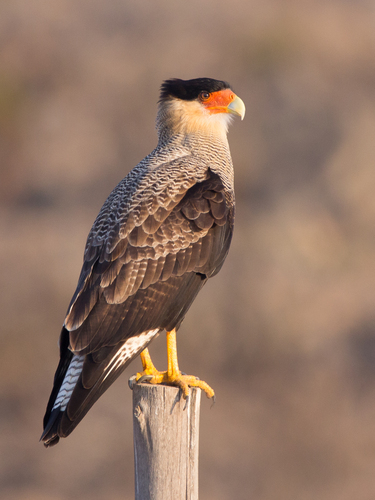
Crested Caracara
The Crested Caracara (*Caracara plancus*) is a striking bird of prey found across a wide range of the Americas. Unlike many falcons, it's a generalist, often seen walking or running on the ground, scavenging for carrion, or hunting small prey. This adaptability has allowed it to thrive in diverse habitats, from open grasslands to agricultural areas. The caracara plays a crucial role in its ecosystem as both a scavenger and a predator, helping to control populations of smaller animals and remove carcasses. It holds cultural significance in some regions, featuring in folklore and sometimes referred to by names reflecting its distinctive calls or behaviors.
49-64 cm
Length
107-132 cm
Wingspan
Least Concern
Conservation Status
Distribution
The Crested Caracara's range extends from the southern United States (Florida, Texas, Arizona) through Central America and much of South America, reaching as far south as Tierra del Fuego. It is largely non-migratory, though some populations may make local movements in response to food availability.
Lifespan
Up to 30 years in captivity; wild lifespan is likely shorter, but precise data is limited.
Crested Caracara's Habitat
Habitat Types
Open grasslands, Savannas, Agricultural fields, Pastures, Deserts, Scrublands, Coastal areas
Climate Zones
Tropical, Subtropical, Temperate
Adaptations
The Crested Caracara's long legs and relatively flat feet are adaptations for ground foraging. Its strong beak is capable of tearing flesh from carcasses, and its sharp talons are used for capturing live prey.
Variations
Several subspecies are recognized, differing slightly in size and plumage coloration. These variations are often subtle and reflect geographic isolation.
Appearance
Breeding Plumage
Plumage is generally consistent year-round.
Seasonal Feather Changes
Minimal seasonal variation.
Sex Based Plumage Differences
Males and females have similar plumage.
Notable Features
Black cap and prominent crest, White neck and throat, Red facial skin (cere), Black and white barred underparts, Long, yellow legs
Diet and Feeding
Primary Foods
Carrion, Small mammals, Reptiles, Amphibians, Birds, Insects, Fish, Eggs
Foraging Behavior
Crested Caracaras are opportunistic feeders. They often walk or run on the ground, searching for prey or carrion. They may also perch on fence posts or trees to scan for food. They are known to follow vultures to carcasses and sometimes steal food from other birds.
Specializations
Their strong legs and feet allow them to run down prey or dig for insects and other invertebrates. Their strong beak is adapted for tearing flesh.
Seasonal Diet Variations
Diet may vary depending on prey availability. In some areas, they may consume more insects during certain seasons, while in others, they may rely more on carrion.
Behavior
Social Structure
Crested Caracaras are often seen alone or in pairs, but they may gather in larger groups at abundant food sources, such as carcasses. They are not typically considered highly social.
Communication
Loud, rattling calls, Cackling sounds, Head-bobbing displays, Crest raising
Migration
Generally non-migratory, although some populations may undertake local movements in response to food availability or weather conditions.
Territorial or Group Behaviors
Pairs defend territories during the breeding season. Outside of breeding, they may tolerate other caracaras, especially at feeding sites.
Conservation
Threats
Habitat loss (due to agriculture and urbanization), Pesticide exposure, Collisions with vehicles, Shooting (in some areas, perceived as a pest)
Protection Programs
Monitoring programs in some regions, Habitat restoration efforts, Public education campaigns
Local National Laws
Protected under the Migratory Bird Treaty Act in the United States.
Population Trend
Stable
Population Estimates
Global population estimates are not precise, but the species is considered relatively common within its range.
Interesting Facts
Crested Caracaras are sometimes called "Mexican Eagles."
This reflects their presence in Mexico and their eagle-like appearance, although they are more closely related to falcons.
They are known to flip over cow patties and other objects to find insects.
This behavior demonstrates their opportunistic foraging strategies.
They often associate with vultures.
They follow vultures to carcasses and may even displace them to feed.
The bare facial skin can change color with mood.
It may become more intensely red when the bird is excited or agitated.
Faqs about Crested Caracara
Are Crested Caracaras dangerous to humans?
No, Crested Caracaras are not typically aggressive towards humans. They may approach if accustomed to being fed, but they pose little threat.
What is the difference between a Crested Caracara and a Golden Eagle?
While both are large birds of prey, Golden Eagles are much larger and have a different plumage (primarily dark brown). Crested Caracaras have a distinctive black cap, white neck, and red facial skin. Golden Eagles are also true eagles (family Accipitridae), while Crested Caracaras are falcons (family Falconidae).
Do Crested Caracaras make good pets?
No, Crested Caracaras are wild birds and are not suitable as pets. They require specialized care and large spaces, and it is illegal to keep them as pets in many areas.
Why do Crested Caracaras have bare facial skin?
The bare facial skin, or cere, is thought to help keep the bird clean when feeding on carrion, preventing feathers from becoming soiled. It may also play a role in thermoregulation and communication.
Copyright @ Nature Style Limited. All Rights Reserved.
 English
English